CENTRAL BERLIN: SCHEUNENVIERTEL
From the mid-19th-century onwards, the Scheunenviertel (“barn quarter”) was home to thousands of poor Jewish migrants. After World War II the area was entirely neglected and fell into decay. It has been rejuvenated in recent decades and many historic merchants’ yards and narrow side streets have been restored, reviving the quarter’s unique and lively character. With its new restaurants, galleries and shops, the district has become fashionable. The tragic history of its former inhabitants, however, remains unforgotten.

1. Oranienburger Straße
![]() Mitte, between Friedrichstr. and Rosenthaler Str.
Mitte, between Friedrichstr. and Rosenthaler Str.
Located in the centre of old Scheunenviertel, Oranienburger Straße symbolizes the rise and fall of Jewish culture in Berlin like no other street does. Traces of its Jewish past are visible at the Neue Synagoge and several Jewish cafés and restaurants (see Oranienburger Straße). Some 18th- and 19th-century buildings attest to the street’s former splendour – the Postfuhramt with its ornate façade, for example, or the house at No. 71–72, built in 1789 by Christian Friedrich Becherer for the Grand Lodge of the German Freemasons. The area is also great for a night out – visit one of the many bars and clubs (see Pubs, Bars and Nightclubs) lining the street.

Richly decorated Postfuhramt building
2. Neue Synagoge
![]() Oranienburger Str. 28–30 • Open 10am–8pm Sun & Mon, 10am–6pm Tue–Thu, 10am–5pm Fri • Adm • www.cjudaicum.de
Oranienburger Str. 28–30 • Open 10am–8pm Sun & Mon, 10am–6pm Tue–Thu, 10am–5pm Fri • Adm • www.cjudaicum.de
Once the largest in Europe, the New Synagogue was opened in 1866. In 1938, it survived Kristallnacht thanks to a brave guard, but it was damaged by bombs during World War II. Behind the splendid Moorish façades are a prayer room and the Centrum Judaicum.

Striking dome of the Neue Synagoge
3. Hackesche Höfe
![]() Rosenthaler Str. 40–41
Rosenthaler Str. 40–41
Berlin’s largest and most attractive group of restored commercial buildings, Hackesche Höfe extends from Oranienburger to Rosenthaler Straße. The complex, comprising eight interconnecting courtyards, was designed around the turn of the 20th century by August Endell and Kurt Berndt, two leading exponents of the Jugendstil. The first courtyard especially has elements typical of the style: geometric motifs on vibrant glazed tiles cover the building. The complex has been carefully restored and is a popular centre of nightlife.
4. Sophienstraße
![]() Große Hamburger Str. 29
Große Hamburger Str. 29
Narrow Sophienstraße has been beautifully restored and looks just as it did in the late 18th century. The buildings and courtyards now host shops and arts and crafts workshops. The Baroque Sophienkirche nearby, the first Protestant parish church, was founded by Queen Sophie Luise in 1712 (see Sophienkirche). Next to it is a cemetery with some tombs dating back to the 18th-century.
5. Brecht-Weigel-Gedenkstätte
![]() Chausseestr. 125 • (030) 200 571 844 • Open 10am–noon & 2–3:30pm Tue, 10–11:30am Wed & Fri, 10am–noon & 5–6:30pm Thu, 10am–3:30pm Sat, 11am–6pm Sun • Adm • www.adk.de/en/archive
Chausseestr. 125 • (030) 200 571 844 • Open 10am–noon & 2–3:30pm Tue, 10–11:30am Wed & Fri, 10am–noon & 5–6:30pm Thu, 10am–3:30pm Sat, 11am–6pm Sun • Adm • www.adk.de/en/archive
Bertolt Brecht, one of the greatest playwrights of the 20th century, lived here with his wife, Helene Weigel, between 1953 and 1956. On display are original furnishings, documents and photographs.
6. Museum für Naturkunde
The Museum of Natural History (see Museum für Naturkunde) is one of the largest of its kind and has the world’s largest dinosaur skeleton: a brachiosaurus found in Tanzania. Also on display are fossils, meteorites and minerals.
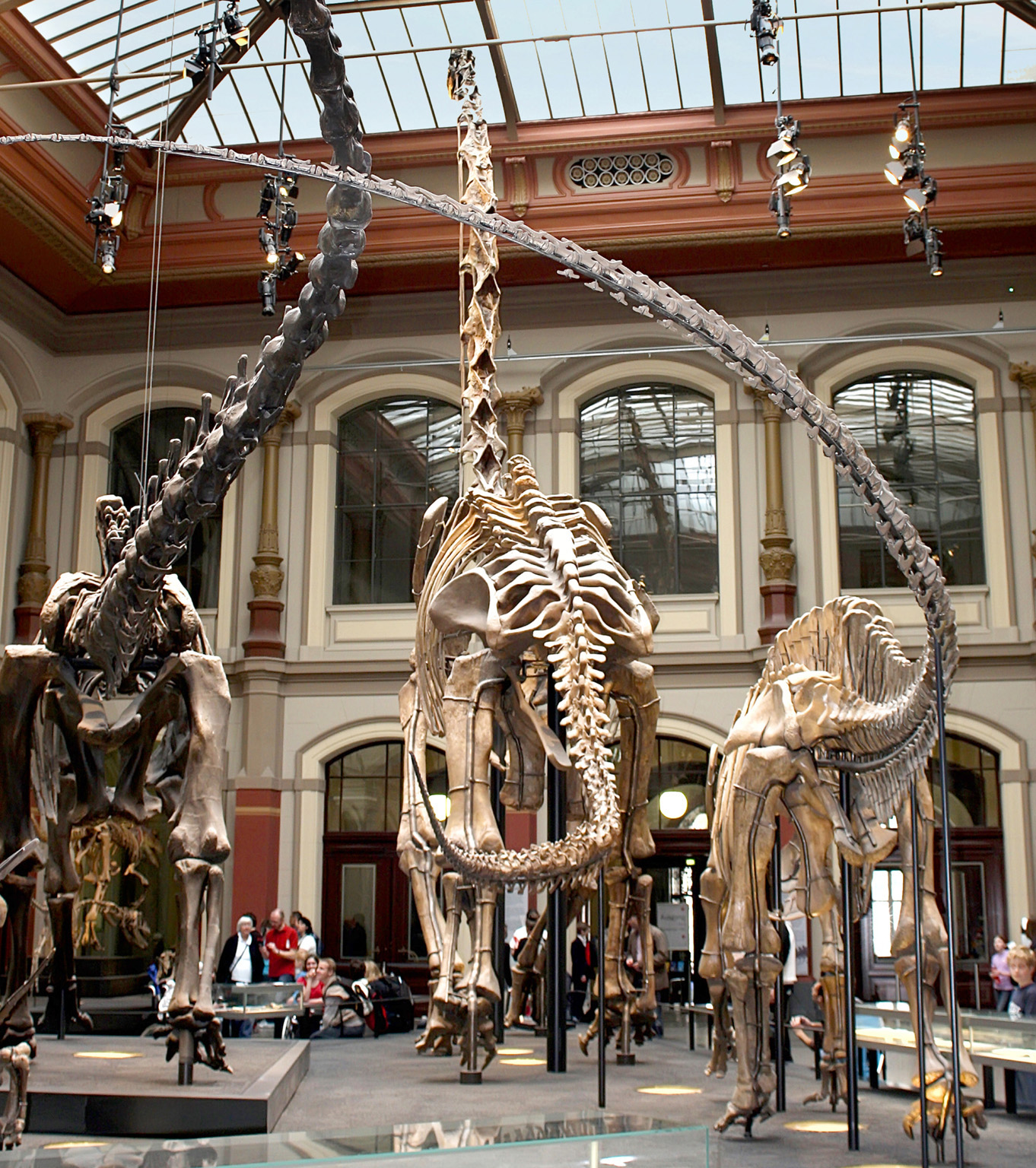
Museum für Naturkunde
7. Dorotheenstädtischer Friedhof
![]() Chausseestr. 126 • Open summer: 8am–8pm daily (winter: until sunset)
Chausseestr. 126 • Open summer: 8am–8pm daily (winter: until sunset)
This is a striking cemetery dating back to 1762. To the left of the entrance are the graves of Heinrich Mann (1871–1950) and Bertolt Brecht (1898–1956); further along are the pillar-like tombstones of Johann Gottlieb Fichte (1762–1814) and Georg Wilhelm Friedrich Hegel (1770–1831). On Birkenallee (left off the main path) are the graves of Karl Friedrich Schinkel (1781–1841), Friedrich August Stüler (1800–65) and Johann Gottfried Schadow (1764–1850).
8. me Collectors Room Berlin
![]() Auguststr. 68 • (030) 86 00 85 10 • Open noon–6pm Tue–Sun • Adm • www.me-berlin.com
Auguststr. 68 • (030) 86 00 85 10 • Open noon–6pm Tue–Sun • Adm • www.me-berlin.com
Featuring the private collections of Thomas Olbricht and other art collectors, this gallery has works spanning the 16th century to present times. It organizes exhibitions, workshops and concerts on contemporary art. The upper floor houses Olbricht’s “cabinet of curiosities”, showcasing exotic, mysterious and dark objects.
9. Gedenkstätte Große Hamburger Straße
![]() Große Hamburger Str. • www.jg-berlin.org/en.html
Große Hamburger Str. • www.jg-berlin.org/en.html
Before 1939, this was a thoroughly Jewish street, with Jewish schools, the oldest Jewish cemetery in Berlin and an old people’s home. The latter achieved tragic fame during the Nazi period – the SS used it as a detention centre for Berlin’s Jews before transporting them to concentration camps. A monument commemorates the thousands who were sent to their death from here. To the left of the home is a Jewish school, on the site of an earlier school founded in 1778 by the Enlightenment philosopher Moses Mendelssohn (1729–86). To the right is the Alter Jüdischer Friedhof (old Jewish cemetery), where some 12,000 of Berlin’s Jews were buried between 1672 and 1827. It was almost destroyed by the Nazis in 1943, and in 1945 it was converted into a park. Only a few Baroque tombstones or masebas survived; these are now fixed into the original cemetery wall. The spot thought to be Mendelssohn’s tomb is marked by a maseba.
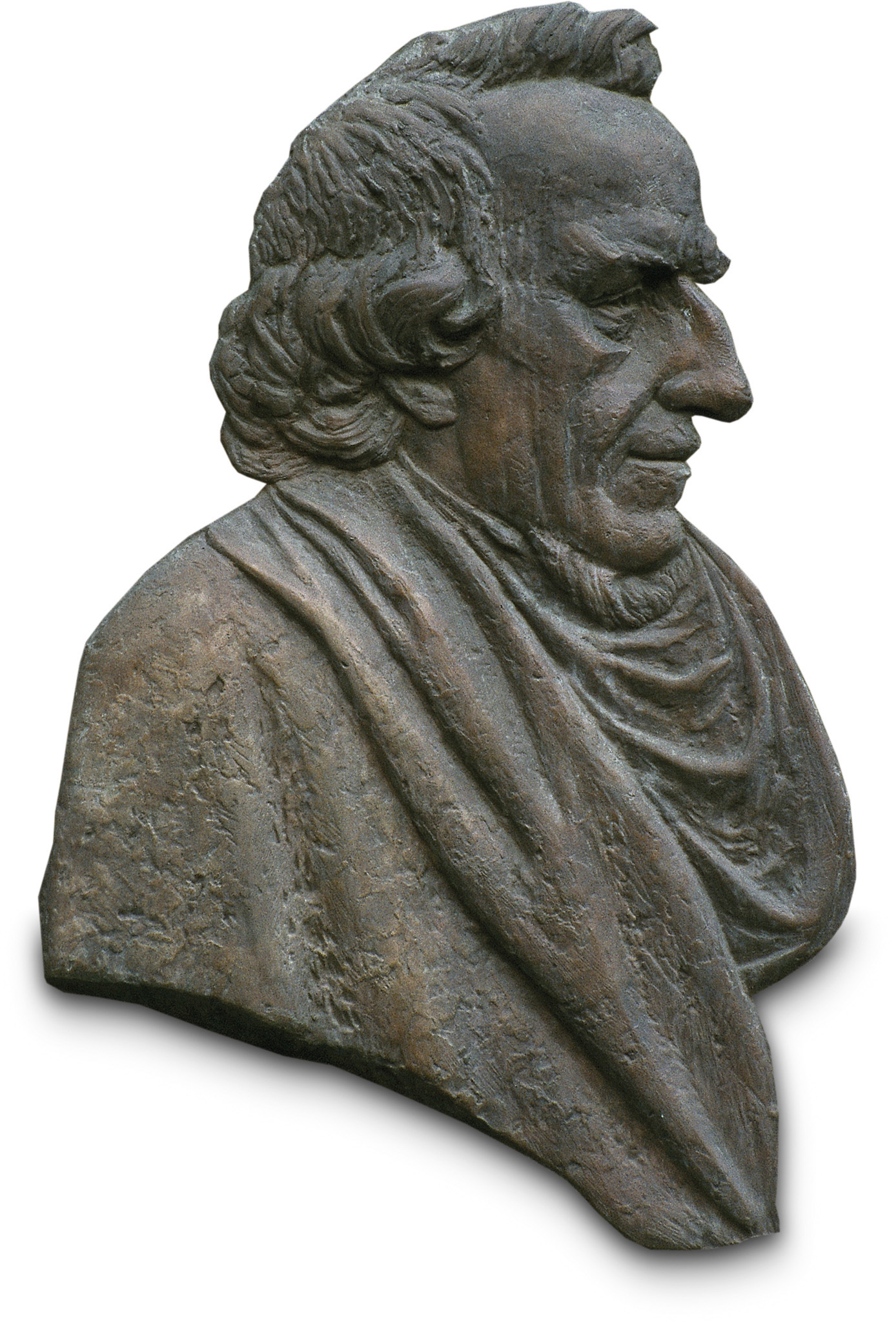
Moses Mendelssohn
10. Postfuhramt
![]() Oranienburger Straße 35
Oranienburger Straße 35
The richly ornamented Postfuhramt (post office transport department) dates from the 19th century. The building was used as an exhibition space, but it is now the head office of a medical technology firm.
JEWISH BERLIN
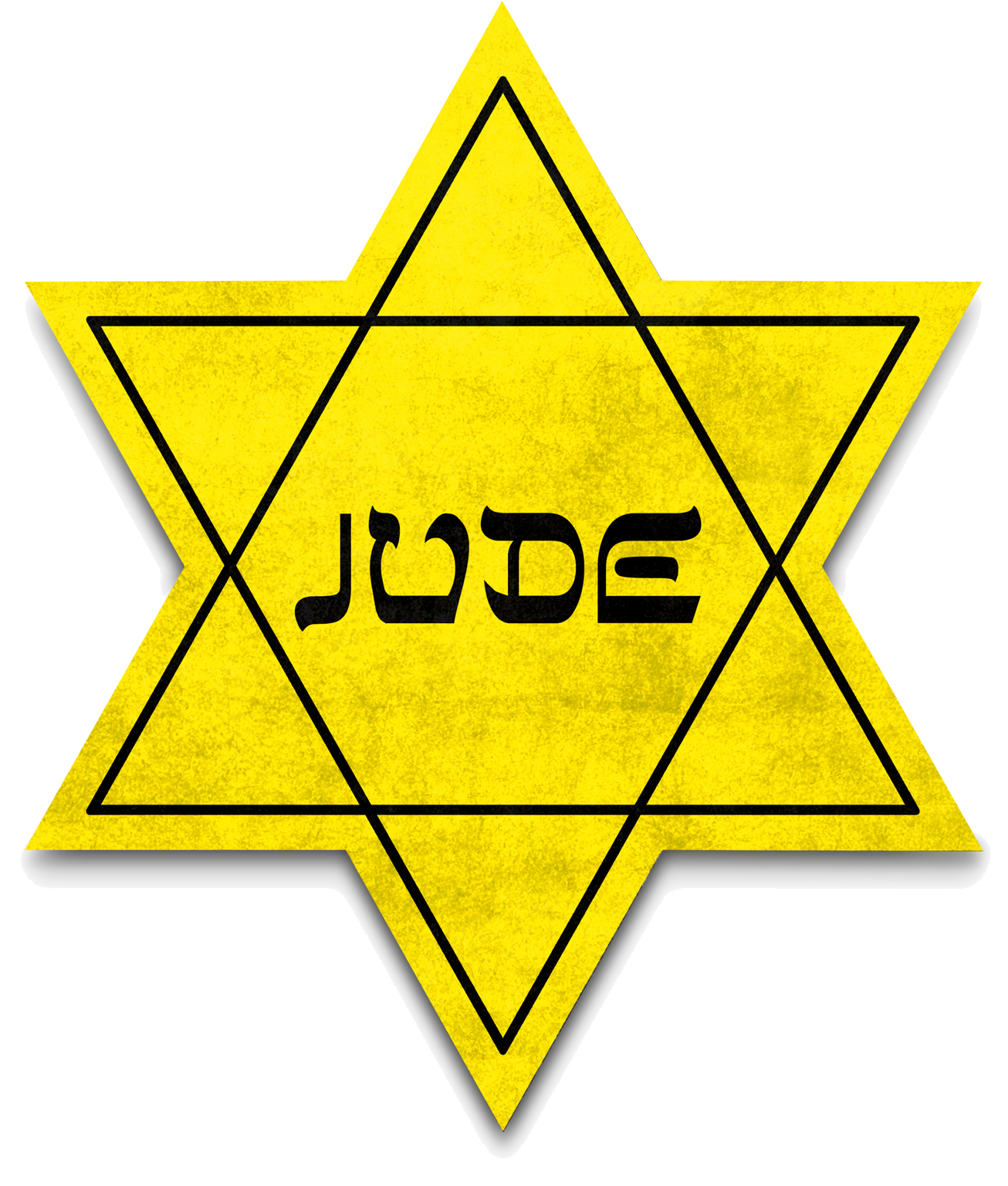
In the 19th century, Berlin had a population of 200,000 Jews, the largest such community in Germany. Apart from the wealthier Jews who lived in the west of the city, it included many Jewish migrants from Eastern Europe. They settled in Spandauer Vorstadt, primarily in Scheunenviertel, an impoverished part of the district that had the reputation of being a criminal red-light area. Later, Nazi propaganda used that name to denote the whole area to tarnish all Jews by association. Nazi stigmatization of Jews also included the enforced public wearing of a Star of David. The Jewish quarter is still known as Scheunenviertel, but very few Jews live here now. Only some 5,000 Jewish Berliners survived the 1933–45 persecution.
A DAY IN SCHEUNENVIERTEL
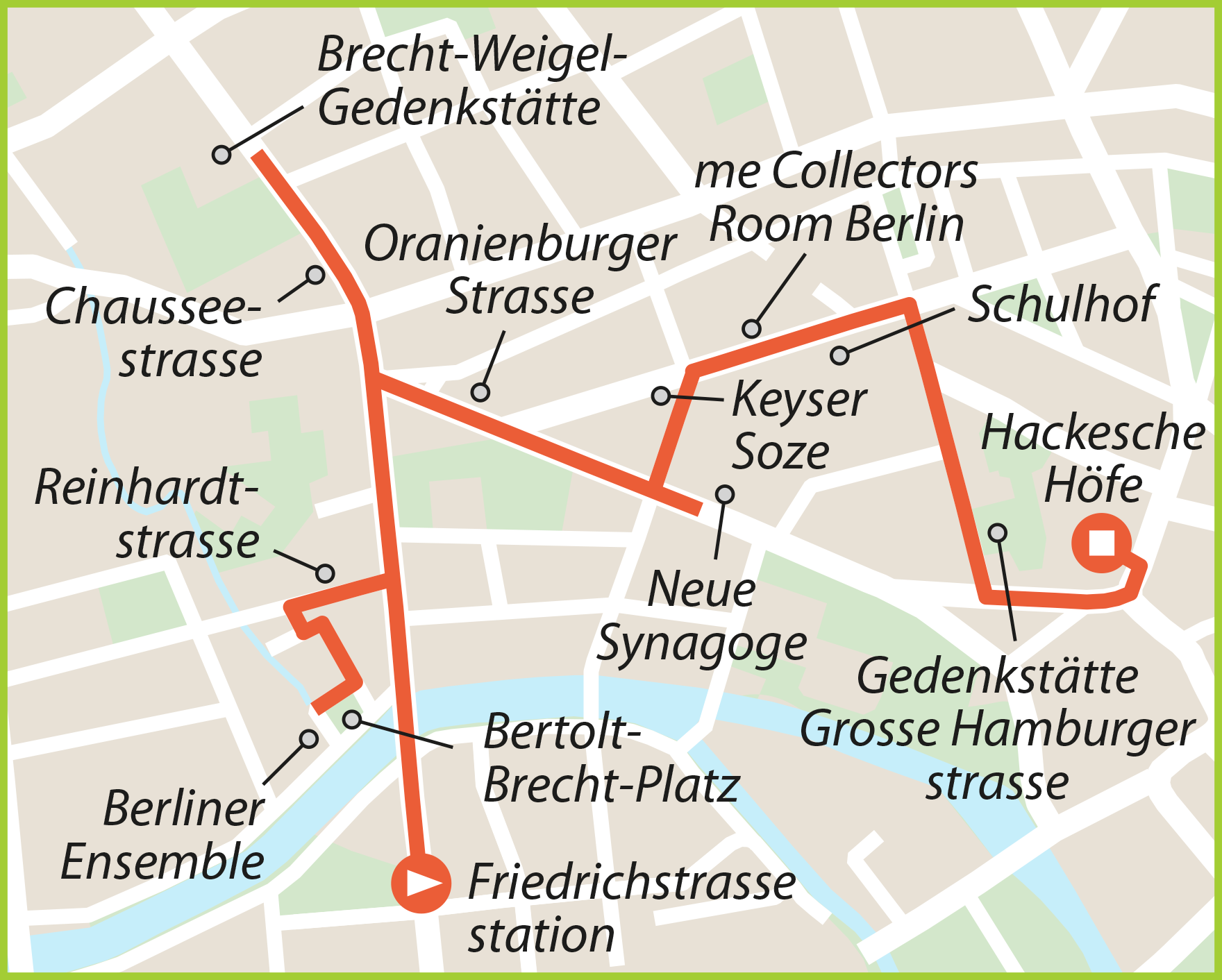
MORNING
Take the S-Bahn to Berlin’s former entertainment district at Friedrichstraße and explore this vibrant, glamorous street. Then walk north up to Reinhardstraße, opposite the Friedrichstadt-Palast, and turn left here towards Bertolt-Brecht-Platz. Continue south to Albrechtstraße to the Berliner Ensemble. Admire the theatre where Bertolt Brecht used to work, then make a detour to visit his home, the Brecht-Weigel-Gedenkstätte. The best way to get there is on foot – return to Friedrichstraße and walk north to Chausseestraße. Then retrace your steps and turn left into Oranienburger Straße to get to the heart of fashionable Scheunenviertel. About a 7-minute walk down the street will bring the dome of the Neue Synagoge into view.
AFTERNOON
Before exploring further, stop for some refreshments; not far from the synagogue is the Keyser Soze café (see Beth-Café). Continue along Tucholskystraße, then turn right into Auguststraße. Some of the most attractive courtyards are here, such as the old-world Schulhof at No. 21. A little ahead is the interesting me Collectors Room Berlin art gallery. Continue along Auguststraße then turn right for the Gedenkstätte Große Hamburger Straße and the Hackesche Höfe. Shop a little, then round off your tour of Scheunenviertel with an evening meal at one of its restaurants.
The Best of the Rest
1. Charité
![]() Schumannstr. 20–21 • (030) 450 536 156 • Medizin historisches Museum: open 10am–5pm Tue, Thu, Fri, Sun, 10am–7pm Wed & Sat
Schumannstr. 20–21 • (030) 450 536 156 • Medizin historisches Museum: open 10am–5pm Tue, Thu, Fri, Sun, 10am–7pm Wed & Sat
Many renowned physicians, such as Rudolf Virchow and Robert Koch, worked and taught at this world-famous hospital, founded in 1710. The Museum of Medical History has some 750 remarkable exhibits on display.

Exhibit at the Charité museum
2. Alte and Neue Schönhauser Straße
![]() Hackescher Markt
Hackescher Markt
Alte Schönhauser Straße is one of the oldest streets in Spandauer Vorstadt. It is characterized by a colourful jumble of traditional and new fashion shops.
3. Deutsches Theater
![]() Schumannstr. 13A • (030) 28 44 12 25 • www.deutschestheater.de/english
Schumannstr. 13A • (030) 28 44 12 25 • www.deutschestheater.de/english
Once the place of work (see Deutsches Theater) of Max Reinhardt, this theatre – widely considered the best German-language theatre – shows mainly German classics, often in new interpretations.
4. Berliner Ensemble
![]() Bertolt-Brecht-Platz 1 • (030) 28 40 81 55
Bertolt-Brecht-Platz 1 • (030) 28 40 81 55
This theatre, established in 1891–2 by Heinrich Seeling, was the main venue for Bertolt Brecht’s plays.
5. Hochbunker
![]() Reinhardtstr 20
Reinhardtstr 20
One of the last surviving World War II bunkers in Berlin, this imposing building now houses the Boros Art Collection gallery.
6. Monbijoupark
![]() Oranienburger Str./Spree
Oranienburger Str./Spree
A small park, in which once stood the little Monbijou palace, Monbijoupark is now a green space for a break.
7. Auguststraße
![]() Between Oranienburger and Rosenthaler Str.
Between Oranienburger and Rosenthaler Str.
The area round this road harks back to old Scheunenviertel, featuring interior courtyards and now brimming with art galleries.
8. Koppenplatz
![]() Near Auguststr.
Near Auguststr.
In this small square, a monument of a table and upturned chair recall the expulsion of the Jews.
9. Sophienkirche
![]() Große Hamburger Str. 29
Große Hamburger Str. 29
This parish church, built in 1712, has managed to preserve its traditional old Berlin charm. Be sure not to miss the Baroque pulpit.

The imposing Baroque Sophienkirche
10. Tucholskystraße
This narrow street is typical of the transformation of Scheunenviertel – trendy shops next to both decaying and beautifully renovated façades.
Old Courtyards
1. Sophie-Gips-Höfe
![]() Sophienstr. 21–22
Sophienstr. 21–22
Famous for the Hoffman art collection, which is based here, this former sewing machine factory is a popular meeting place.
2. Sophienhöfe
![]() Sophienstr. 17–18
Sophienstr. 17–18
The 19th-century red-brick artisans’ workshops have been transformed into artists’ studios and a theatre.
3. Heckmann-Höfe
![]() Between Oranienburger Str. 32 and Auguststraße 9
Between Oranienburger Str. 32 and Auguststraße 9
These lavishly restored yards in a candy factory attract visitors with a restaurant and fashionable shops.
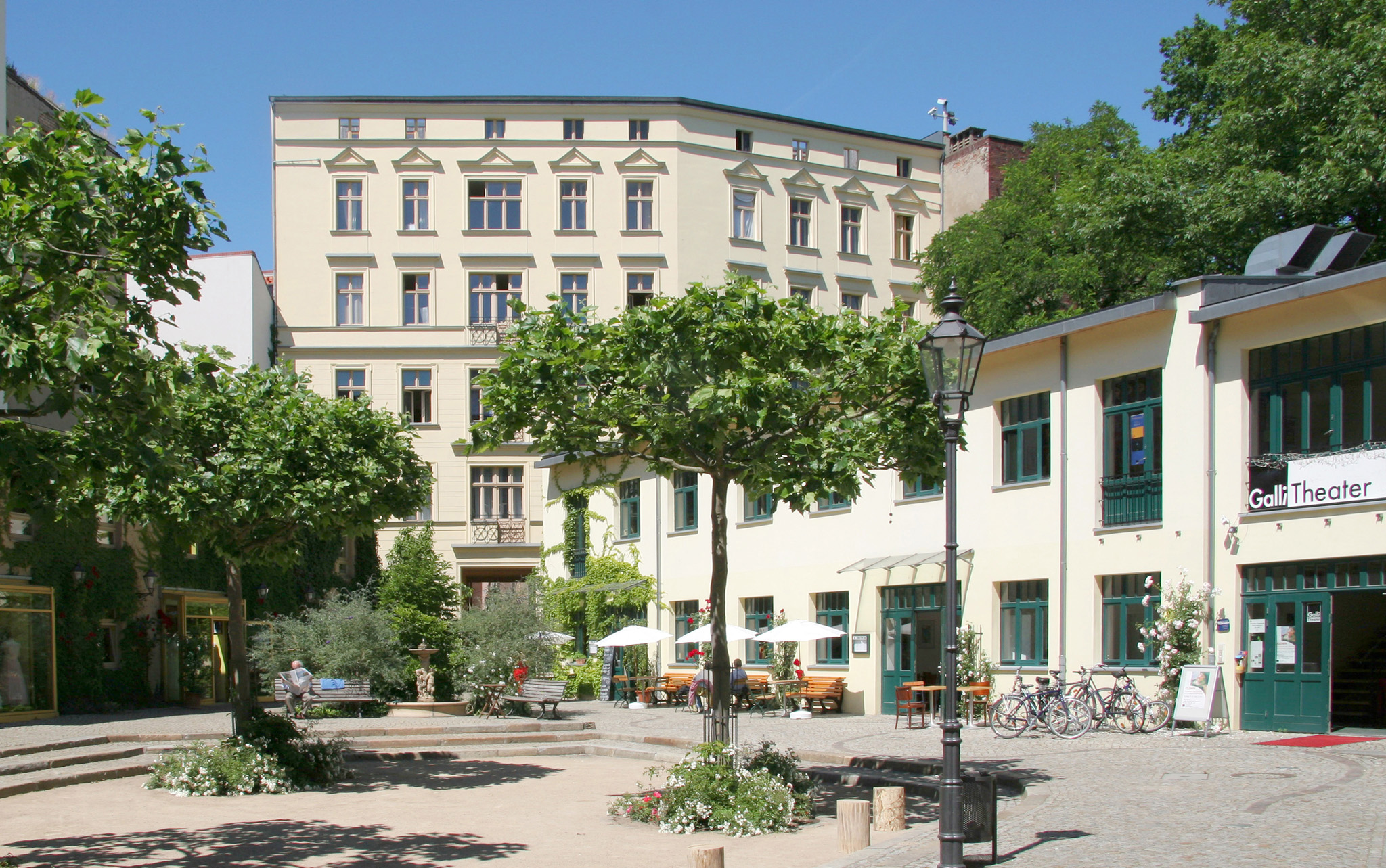
Courtyards of Heckmann-Höfe
4. Sophienstr. 22 and 22A
Two small inner courtyards, partially planted, are surrounded by yellow and red-brick walls.
5. Rosenthaler Straße 37
This green-tiled courtyard is unique. Once part of the Wertheim department store, it now houses a boutique and tapas bar. The 1775 townhouse through which it is accessed has a beautiful wooden staircase.
6. Schulhof
![]() Auguststr. 21
Auguststr. 21
Time seems to have stood still around 1900 in this courtyard, which houses an elementary school.
7. Hof Auguststraße 5A
The extensive courtyard of the former Postfuhramt permits a glimpse of the original façade of the building.
8. Rosenthaler Straße 39
Berlin’s post-Wall subculture of edgy art collectives is still alive and well in this unrenovated courtyard.
9. Kunsthof
![]() Oranienburger Str. 27
Oranienburger Str. 27
A courtyard full of nooks and crannies, which is today occupied by a number of workshops, offices and cafés. Take a look at the richly ornamented staircases.
10. Kunst-Werke (KW)
![]() Auguststr. 69
Auguststr. 69
Large-scale installations by the resident artists are regularly on display at this well-known centre for contemporary art; artists-in-residence have included Susan Sontag. The courtyard has a café designed by US artist and curator Dan Graham in the conservatory.

The Kunst-Werke courtyard
Pubs, Bars and Nightclubs
1. Buck and Breck
![]() Brunnenstr. 177 • Open 7pm–2am daily
Brunnenstr. 177 • Open 7pm–2am daily
A bar with an intimate setting, Buck and Breck specializes in fine cocktails.
2. Bellini Lounge
![]() Oranienburger Str. 42 • (030) 97 00 56 18 • Open 6pm–2am daily
Oranienburger Str. 42 • (030) 97 00 56 18 • Open 6pm–2am daily
Some of the most authentic tropical cocktails north of the equator.
3. B-flat
![]() Dircksenstr. 40 • (030) 283 31 23 • Open from 8pm Sun–Thu, from 9pm Fri & Sat
Dircksenstr. 40 • (030) 283 31 23 • Open from 8pm Sun–Thu, from 9pm Fri & Sat
Live jazz, and occasionally dancing, are on offer at this small venue.
4. Reingold
![]() Novalistr. 11 • (030) 28 38 76 76 • Open from 7pm Tue–Sat
Novalistr. 11 • (030) 28 38 76 76 • Open from 7pm Tue–Sat
A relaxed bar with a 1920s ambience, Reingold is perfect for a nightcap.
5. Betty F
![]() Mulackstr. 13 • (030) 304 717 440 • Open from 9pm daily
Mulackstr. 13 • (030) 304 717 440 • Open from 9pm daily
A gay and straight pub paying ironic homage to former US First Lady Betty Ford. The bar serves great cocktails.
6. Grand Rocka
![]() Am Zwirngraben 6–7 • (030) 24 63 86 06 • Open from 9am daily
Am Zwirngraben 6–7 • (030) 24 63 86 06 • Open from 9am daily
This bar and restaurant is good for people-watching and enjoying a beer.

The trendy interior of Grand Rocka
7. Cordobar
![]() Große Hamburger Str. 32 • (030) 27 58 12 15 • Open 7pm–2am Tue–Sat, 6pm–midnight Sun
Große Hamburger Str. 32 • (030) 27 58 12 15 • Open 7pm–2am Tue–Sat, 6pm–midnight Sun
This relaxed wine bar has an impressive cellar consisting of mainly German and Austrian wines.
8. Yosoy
![]() Rosenthaler Str. 37 • (030) 28 39 12 13 • Open from 11am daily
Rosenthaler Str. 37 • (030) 28 39 12 13 • Open from 11am daily
Tasty tapas, good wines and exciting cocktails are served at this attractively furnished Spanish restaurant – which is why it is usually crowded late into the night.
9. Kaffee Burger
![]() Torstr. 58–60 • (030) 28 04 64 95 • Open from 8pm daily
Torstr. 58–60 • (030) 28 04 64 95 • Open from 8pm daily
Thanks to its quirky record release parties, movie screenings and readings, this pub and music venue is a firm favourite with East Berlin hipsters.
10. Oxymoron
![]() Rosenthaler Str. 40–41 • (030) 28 39 18 86 • Open from 9am daily
Rosenthaler Str. 40–41 • (030) 28 39 18 86 • Open from 9am daily
This small bar, club and restaurant in popular and lively Hackesche Höfe, features chintz decoration and serves light German and international meals.
Restaurants
1. Chen Che
![]() Rosenthaler Str. 13 • (030) 28 88 42 82 • Open noon–midnight daily • €€
Rosenthaler Str. 13 • (030) 28 88 42 82 • Open noon–midnight daily • €€
This Vietnamese teahouse-style restaurant offers fresh food and has a tranquil bamboo garden.
2. Rutz
![]() Chausseestr. 80 • (030) 24 62 87 60 • Open from 6:30pm Tue–Sat • €€€
Chausseestr. 80 • (030) 24 62 87 60 • Open from 6:30pm Tue–Sat • €€€
Enjoy exceptional dishes created using local ingredients at this cosy restaurant (see Rutz).
3. Monsieur Vuong
![]() Alte Schönhauser Str. 46 • (030) 99 29 69 24 • Open noon–midnight daily • €
Alte Schönhauser Str. 46 • (030) 99 29 69 24 • Open noon–midnight daily • €
This tiny Vietnamese snack joint serves delicious Asian dishes.
4. Pauly Saal
![]() Auguststr. 11 • (030) 33 00 60 70 • Open 3–6pm & 6pm–3am Mon–Sat • €€€
Auguststr. 11 • (030) 33 00 60 70 • Open 3–6pm & 6pm–3am Mon–Sat • €€€
A classy Michelin-starred restaurant in a former school that also houses art galleries. Its wine list is extensive.
5. Beth-Café
![]() Tucholskystr. 40 • (030) 281 31 35 • Open 11am–5pm Fri, 11am–8pm Sun–Thu • No credit cards • €
Tucholskystr. 40 • (030) 281 31 35 • Open 11am–5pm Fri, 11am–8pm Sun–Thu • No credit cards • €
Small Jewish café of the Adass-Jisroel community, serving Jewish snacks and kosher wines and beers.
6. Hackescher Hof
![]() Rosenthaler Str. 40–41 • (030) 283 52 93 • Open from 8am Mon–Fri (from 9am Sat & Sun) • €€
Rosenthaler Str. 40–41 • (030) 283 52 93 • Open from 8am Mon–Fri (from 9am Sat & Sun) • €€
The best restaurant in Hackesche Höfe serves delicious local produce.
7. Nola’s am Weinberg
![]() Veteranenstr. 9 • (030) 44 04 07 66 • Open 10am–1am daily • €€
Veteranenstr. 9 • (030) 44 04 07 66 • Open 10am–1am daily • €€
The Swiss cuisine served here is surprisingly inspired. Try one of their delicious fondues. There is a lovely outdoor terrace.

Fondue at Nola’s am Weinberg
8. Alpenstück
![]() Gartenstr. 9 • (030) 21 75 16 46 • Open 6pm–1am daily • €€
Gartenstr. 9 • (030) 21 75 16 46 • Open 6pm–1am daily • €€
The best of the area’s homely restaurants serving traditional, hearty fare from southern Germany and Austria in a cosy setting, decorated in an Alpine style.
9. Kamala
![]() Oranienburger Str. 69 • (030) 283 27 97 • Open noon–11:30pm daily • €€
Oranienburger Str. 69 • (030) 283 27 97 • Open noon–11:30pm daily • €€
This hidden gem offers diners traditional Thai cuisine along-side an impressive wine list. Kamala is good value for money.
10. Bandol sur Mer
![]() Torstraße 167 • (030) 67 30 20 51 • Open 6–10pm Thu–Mon • €€€
Torstraße 167 • (030) 67 30 20 51 • Open 6–10pm Thu–Mon • €€€
A prestigious Michelin-starred restaurant, Bandol sur Mer is casual with a bistro-style open kitchen. They offer flavourful French dishes which are beautifully plated.
